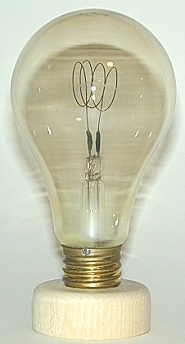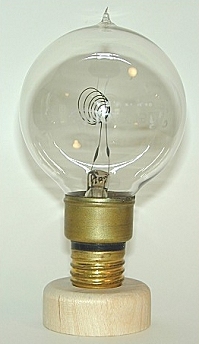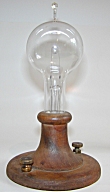X-ray
Geissler
Crookes
Radio
Box art
Dr. Hugh Hicks
S.Slabyhoudek
M-Jay
Fort Myers, FL.
Monsieur Ara
Fin Stewart
Related links
Submit a link |
|
| FAQ...and
the BulbCollector mailbag
|
Ninety percent of the email generated from this site
comes from people inquiring about the value of their
old light bulb. Of that percentile, the majority
of bulbs in question are fairly typical tungsten
cage filament and ca.1905 carbon filament
bulbs. High ranks also go out to heat therapy bulbs,
such as those made by Nalco, Varicare, etc. Also
high on this list of inquiries are neon  and
Austrian medium base figural bulbs. and
Austrian medium base figural bulbs.
At the opposite
end of the spectrum it is interesting to make light
of the more
entertaining requests I get. For example, since
the start of this site I have had three requests
(from three different individuals) regarding the
light bulbs used in the prop for the
classic HG Wells movie The Time Machine.
I'm
sorry to say that I haven't been of much help in
this area, I don't have any time machine light
bulbs for sale.
Neon Osglim lamps have been a
favorite among followers of the spiritual author
Lobsang
Rampa. Decades ago Rampa proclaimed a
human aura could actually be seen in a dark room
using a very dim light source. The Osglim
seems to be the bulb of choice, or one recommended
by Rampa himself. Several letters have reached
the BulbCollector desk from new and veteran spiritualists
alike seeking these bulbs. Not being clairvoyant
myself, I have no magic way of locating Osglim
bulbs- sorry.
This FAQ was written for non-collectors to help
answer some of these questions and establish
some very basic values of more common vintage
light bulbs that I am asked about on a frequent
basis. To add more of a personal touch I have included
some of the email received here and my responses
to those emails (names withheld).
Common Carbon & Tungsten Bulbs
|
|
A typical 16 candle power carbon filament
bulb with black glass base insulation, circa
1905.
Value: around $10.00 if working and in good
condition. |
A typical Mazda tungsten cage filament
bulb, circa 1915.
Value: around $10.00 if working and in good
condition. |
Heat Therapy Bulbs
Frequently I receive emails concerning the value
and purpose of vintage light bulbs with thick
spiral carbon filaments often bearing the name
Nalco and Varicare. While it is known earlier
bulbs of the same design were used for precision
optical light sources, the focus here concerns
those
used as theraputic heat sources. These bulbs
were manufactured by various companies during
the 1920s through the 1940s, and perhaps even
later. They were used in theraputic fixtures
like hand held lamps [Fig.1] as well as large
scale "heat bath" appliances. The wattages of
these bulbs usually range from 240 to 260 watts.
Since they were designed as a heating source,
they give off large amounts of heat and little
useful light. Heat therapy bulbs [Fig.2] are
extremely common and have little value or interest
to collectors of antique light bulbs, thus I
value them at around $5.00. There are certain
exceptions that are unique and uncommon such
as earlier tipped versions [Fig.3] and double
filament bulbs [Fig.4]. often bearing the name
Nalco and Varicare. While it is known earlier
bulbs of the same design were used for precision
optical light sources, the focus here concerns
those
used as theraputic heat sources. These bulbs
were manufactured by various companies during
the 1920s through the 1940s, and perhaps even
later. They were used in theraputic fixtures
like hand held lamps [Fig.1] as well as large
scale "heat bath" appliances. The wattages of
these bulbs usually range from 240 to 260 watts.
Since they were designed as a heating source,
they give off large amounts of heat and little
useful light. Heat therapy bulbs [Fig.2] are
extremely common and have little value or interest
to collectors of antique light bulbs, thus I
value them at around $5.00. There are certain
exceptions that are unique and uncommon such
as earlier tipped versions [Fig.3] and double
filament bulbs [Fig.4].
 |
 |
 |
Figure
2 |
Figure 3 |
Figure 4 |
Neon Glow Lights
I am often emailed about light bulbs with "glowing
flowers" that describe figural
neon glow lamps such as those pictured below. In
the United States, these bulbs were first made
beginning in the 1930s and continued to be produced
at least until the 1970s. Most were made by the
Aerolux Light Corporation and production lasted
for many decades. These bulbs continue to be made
today but all are imported from Asia, most being
of far lesser quality than their vintage counterparts.
These bulbs were sold as nightlights, general
decorative objects for the home, and devotional
objects. Hundreds of different bulb styles were
made, the most common being those with flower filaments
and religious symbology. Neon glow lights with
comic characters and advertising logos inside are
some of the more sought after types. Bulbs that
glow lavendar-purple are typically more appealing
to collectors becuase of the beautful color produced.
|
|
Glowing
flower light bulbs such as this that light
in a pink-orange [neon] color, circa 1930s-1960s.
Value: around
$25.00 in good working condition. |
Glowing
flower light bulbs such as this that light
in a lavendar-purple [argon] color, circa 1930s-1960s.
Value: around
$35.00 in good working condition. |
Related Topics:
BulbCollector
Mail Bag
new mail added when time permits
names omitted for privacy
| Q) "Tim,
you may be an answer to my prayers. I have a
need for some antique bathroom heater bulbs.
I did not know what to call them until I came
across your picture of the GE sausage heater.
I have a circa 1932 home and the two upstairs
bathrooms have in-the-wall, recessed heaters
that appear to use this bulb. The bulbs are GE
and are mounted inverted into the sockets. Each
fixture houses three bulbs of 250 watts each.
The heat produced is tremendous; great for the
bathroom! In my interest to keep the antiquity
of the home, and stay warm, I need to find/purchase
some replacement bulbs. Any help you can give
me will be greatly appreciated." |
 |
A) The
bulbs you are looking for are radiant heat
bulbs. Most were made for use in the old radiant
heaters like the one pictured on my website.
You are about the third person who has contacted
me explaining that these bulbs were used in
bathroom fixtures while restoring their old
homes - interesting! Unfortunately these bulbs
can be difficult to find today and no reproductions
are being made. Your only source is going to
be eBay unless you stumble upon one at a flea
market or antique shop. |
| Q) "Hi, Tim.
We are the proud possessors of a beautiful art
noveau lady lamp. It was produced somewhere between
1910-1930 and came with one working grape cluster
bulb with a standard base that is yellowish in
color. The bulb on your website looks identical
to our bulb except for color and base size. Would
you happen to know where we would be able to
purchase a bulb like that? Any information would
be greatly appreciated." |
 |
A) A
good place to find these would be eBay. Use
a search term such as "grape bulb" and search
on a weekly basis, or use eBay's automated
search which will send an email notification
to you for any auctions that appear having
the heading "grape" and "bulb". They do show
up occasionally but they can be difficult to
find. Don't expect to locate one right away,
it make take months. Also realize it is difficult
to find two bulbs with the same matching color
unless you happen to locate a group of them
being sold in one lot. |
| Q) "Hi there!
I spent a lot of time on your website today,
and I'm hoping you can tell me a little bit about
an old lightbulb that my dad and I found. The
bulb I want info on has a wood base and the bulb
itself has a filament with three loops in it.
It looks quite old, but I don't know if it's
a remake like the ones in the picture. It doesn't
seem to have any tags, stickers, engravings,
etc. How could I tell if it's an original and
not a remake? How long were lightbulbs made with
a wooden base? Do you have a general estimate
on how much an original vs. a remake would sell
for? Any information you can give me would be
great. Thanks a lot." |
 |
A) Thanks
for writing. Without first seeing your bulb,
I'm guessing you have the 1929 Commemorative
lamp, a reproduction made in accordance
to the 50th anniversay of Thomas Edison's first
successful light bulb demonstrated in 1879.
It is the most common commemorative bulb I
get emailed about and many people mistake it
for an authentic early Edison lamp. These
have varied widely in price: $50-$150 or perhaps
more if you had the original box and gold identification
label on the wooden base (often missing.) The
most common traits of the 1929 bulb are bakelite
(plastic like) thumb screws, a looped filament,
wax filled insulated base (look at the underside
of the wood base for the wax filling), etc. On
the other hand, your bulb could be
the 1914 Commemorative lamp which is similar
to the 1929 however the thumb screws are made
of brass, the filament wire coiled tighter,
and the exhaust tip on the top of the bulb
is more authentic than the fake blob on the
1929 edition. The 1914 editions originally
had a round label on the bottom of the wood
base that identified the bulb. They
are a little more valuable and are harder to
find than the 1929 examples. If you can email
some close-up pictures t then I could tell
you for sure which bulb you have. |
| Q) "Dear
Tim, I have an old dental lamp/magnifier. The
filament is broken in the bulb, but other than
that, no other damage. Are there any businesses
that can do such repairs? I am a non-collector
and can't attempt such things myself. Any suggestions?" |
| |
A) Do
you have any pictures of the bulb that you
need to replace? Maybe I could point you in
a better direction for a replacement. Repairing
the filament inside the bulb really is not
an option. Although it has been done with success,
the skills and equipment needed to do the task
are great, only accomplished by someone in
the industry of manufacturing light bulbs.
|
| Q) Hi
Tim, I am so glad I found your site. So interesting!
I hope you can shed a little more light/info
on a bulb I acquired. I have a working purple
aerolux victory bulb & base. Is the V for
victory ie in WWII? or a symbol for an electric
co. or some other advertizing? Do you have any
other info on what the V represents? Do you know
the value? I will appreciate any help or direction
you may provide. Thank you in Advance! |
 |
A) Hello:
yes, you are correct. The "V" symbolizes
Victory and the positive postwar feeling here
in the United States.. The Aerolux Victory
bulb was produced with both an argon fill and
a neon fill which means some bulbs glow pinkish-orange
while others glow a lavender-purple color.
The orange glowing bulbs are harder
to come by and this is unusual since the lavendar
bulbs are typically harder to find - but not
when speaking of this particular glow light.
There were also slight variations in the way
the "V" was
designed in some bulbs. For example most have
a lightning bolt shape going through the letter "V" while
some don't (the bulbs without the lightning bolt
are scarcer). I have seen bulbs in good working
condition with nice clear glass sell in the
$30-$60 range.
|
| Q) I
have a house that was built in the early 1930's.
In my bathroom there are two light fixtures that
are on either side of the bathroom mirror. They
have what looks like florescent bulbs in them.
The bulbs are about 11 inches long. You have
to snap on these caps on the top and bottom of
the bulb and then it pushes into the fixture.
We are remodeling the bathroom
and the fixtures are plastered into a
curved wall. We would like to keep them if it
is possible. The only writing I have found
is on the two caps that snap onto the ends
of the bulb. It says Arrow H&H. Can we save
these? Find bulbs? Any and all help would be
greatly appreciated. |
|
A) The
bulbs that you are searching for are called
Lumiline bulbs. They are long tubular incandescent
lamps that people often confuse with fluorescent
lamps. Lumiline's were highly popular during
this time and were often used for bathroom
and task lighting.
GE still
produces the Lumiline , but prices are high
and range from about $25-$35 per bulb. I would
suggest contacting your local electrical suppliers
first, and then research prices on the Internet.
An Internet search for "Lumiline" will
turn up many online dealers. Before purchasing
your new Lumiline, keep in mind that the new
bulbs have disk shaped ends. You will want
to save any clips or attaching hardware
from your vintage fixture so that you can reuse
them on your new bulb. |
|
|
|
|











